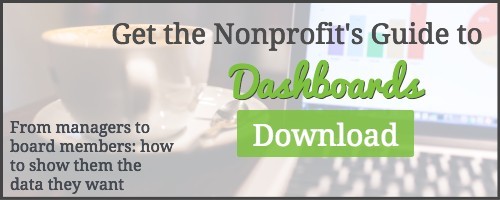As a CFO of a nonprofit, you not only face unique challenges in business and finance but also experience significant pressure to prove you’re making the right decisions about your organization. Board members and stakeholders expect to see you’re making informed and successful decisions about your organization’s financial matters. More than ever, donors want transparency about where their funds go.
The bottom line is that a lot of people are looking to you for visibility into your organization’s effectiveness—do you have a way to show them the data they want and need to see?
If you’re in nonprofit accounting or finance, I can probably bet you have or still do rely on spreadsheets for much, if not all, of your reporting. We are all guilty of it.
However, exporting data and reporting information in spreadsheets takes a lot of time, not to mention how this manual process can be prone to error. And how often do you see spreadsheets from various accountants that are consistent across the team? (Hint: never.) Without efficiency, reliability, or consistency, how can you expect your board or your donors to be able to understand, let alone trust, your data and the decisions you made because of that data?
What’s the solution to your visibility issue? Dashboards.
An Aberdeen study found that 28% of business managers need data to make decisions within an hour of a business event while another 42% need data for informed decision making within a day. That’s not a lot of time for gathering and analyzing data to make important and informed decisions. Static reporting, jumbled spreadsheets, and antiquated systems cannot provide the data you need when you need it. You and your nonprofit need to be able to understand and react quickly to issues that arise.
How do you make the shift from ad hoc to real-time reporting? Dashboards.
The benefits of using dashboards for financial reporting and decision making
We’ve discussed the major pain points nonprofit CFOs and financial managers face when it comes to conveying information to stakeholders. Now, let’s discuss the benefits of using the right tool for visibility: dashboards.
Dashboards serve as valuable visual aids for nonprofit financial teams to make informed decisions quickly and convey key information to their stakeholders. Dynamic dashboards provide real-time data without exporting fumbled data across spreadsheets.
Dashboards for financial reporting and decision making help overcome your visibility problem and provide:
- Financial and operational insights with real-time and at-a-glance views of what matters most to your organization.
- Custom-tailored to show whatever (charts, graphs, calendars, lists, etc.) you and your stakeholders need to see.
- Informed decision making.
- Reliability and efficiency you need to best serve your organization.
Use dashboards responsibly
“Dashboard” is the hot buzzword we’re hearing all the time—everyone wants one! And for good reason. With dashboards, we finally have a single place to look at our most important data. Before you dive into a program creating a dashboard for this and for that, be sure you are prepared to utilize them correctly and to their full potential:
- Work with someone experienced with dashboards to make sure your dashboards reflect your organization’s priorities.
- Ensure each component on your dashboard is built with data that has context. It is not just how you’re trending, but how you’re trending vs. how you thought you would be doing.
- Partner the right types of data together. Homeless shelter utilization combined with jobless rates provides cause and effect impact.
Dashboards giving you visibility into your organization are invaluable. But one thing a dashboard can’t do is give the reader those management insights only the individual manager looking at the data can. A dashboard isn’t the end of the story; it is a stepping stone on the path to effective decision-making.
What to look for in a dashboard
Now that you know dashboards are the solution to your visibility problem and can help increase efficiency and accuracy, let’s look at the best features to look for in a dashboard.
Your dashboards should:
- Be interactive. Static dashboards can’t keep up with real-time reporting and don’t allow you to drill down into the data or KPIs you’re interested in. Dynamic, interactive dashboards keep you informed and in control.
- Use drag and drop features to make building dashboards and reports simple. See what you want, how you want without having to write code.
- Allow you to see current and historical views of your data.
- Filter your various dashboard views to see a specific program, location, project, or other important KPIs.
- Be viewable on your mobile phone or tablet in addition to on your desktop so you can stay informed wherever you are.
If you want control over the financial processes for your nonprofit organization, you need to add dynamic dashboards to your toolbelt. Drill down into important data and give stakeholders a visual picture of the KPIs you’re measuring all while maintaining accuracy and visibility into your organization.


